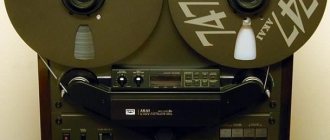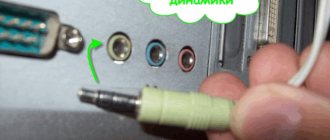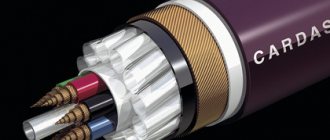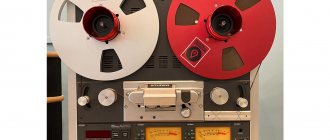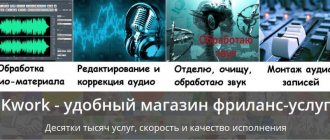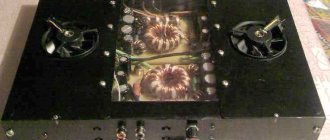Revox B77 Mk II reel deck
We have already reported that Revox has begun shipping factory-restored B77 Mk II models. And finally, the first sample appeared in our country. Realizing how interesting this event would be to magnetic recording enthusiasts, we tested it in a system of high-end components. So, the first Russian test of the updated iconic device with a short background.
THE SECOND COMING
Of all the reel-to-reel cameras that appeared in the late 70s/early 80s, the Revox B77 was considered the undisputed leader in sound quality, and in Moscow thrift stores of that time it cost as much as a slightly used Zaporozhets. Meanwhile, this model, like its predecessor, the A77, was conceived as a semi-professional, but mass-produced model - over all the years of production, from 1978 to 1983, more than 250 thousand copies of the B77s were sold, including the later Mk II model. Depending on the version (more on this below), the price in Germany ranged from 1800 to 2500 DM, and this was very decent money.
It is now clear that the B77 model turned out to be a real middle ground between the too simple and not very convenient to use A77 and the sophisticated PR99, released in 1984. The fact is that the B77 was developed at Willy Studer’s design bureau by the same people who designed the iconic Studer studio machines. The result is obvious - literally polished mechanics, extremely reliable and accurate, like a Swiss watch. For example, the two-track version of the B77 HS (High Speed) that we are going to test has a detonation coefficient at a speed of 38 cm/s that does not exceed 0.05% DIN.
The fact is that the B77 was developed at Willi Studer’s design bureau by the same people who designed the iconic Studer studio machines. The result is obvious.
The direct drive of the drive motor is controlled by the tachometer's magnetic head, which reads the pulses generated by the teeth on the outer rotor. Their frequency is compared with the frequency of the master oscillator, and the error is instantly corrected by the servo system. Switching speeds of 19/38 cm/s is done by changing the frequency of the generator; a Variable Speed mode is also provided - a smooth change in speed within ±10% of the nominal one.
The tape recorder can work with reels up to 27 cm in diameter, with a Small/Large switching button on the front panel. Side motors are asynchronous, with a soft characteristic. Their operating modes are set by thyristors (no relays!), which are connected to an 8-bit processor that controls the entire tape drive. The circuit is optimized in such a way that belt tension monitoring systems are not needed. The automatic stop is optical, the mechanical counter is connected to the right cassette pod, and this is the only belt in the entire structure.
The chassis of the device is cast from aluminum under pressure, the head block is assembled on a milled aluminum plate. The left guide post is rotating, it eliminates parasitic vibrations of the belt. To reduce the background, the reproducing head is covered with a screen during operation, like in adult Studers.
The recording-playback path is assembled exclusively on discrete elements; low-noise Siemens BC550C transistors are installed in the input stages.
The recording-playback path is assembled exclusively on discrete elements; low-noise Siemens BC550C transistors are installed in the input stages. Operational amplifiers are used only in the indicator circuit and in the headphone amplifier. The erase-bias frequency is 150 kHz.
The arrow indication, 0 dB corresponds to a tape magnetization of 257 nWb/m, but an acceptable level of distortion remains up to levels twice as high. The peak indicators (red LEDs) flash at +3 dB above nominal.
The output voltage complies with the DIN standard - 0.775 V at 0 dB.
The sound path is assembled on removable functional modules, which facilitates repair and configuration. Access to the trim elements is provided through holes in the shielding shield when the housing is removed. Previously, the B77 model was produced in several versions - with IEC and NAB correction, with different speeds - from 2 to 38 cm/s, and for each of them its own set of boards was developed. Now Revox is limited to a semi-professional European configuration IEC 19/38 with recording and playback on two tracks.
The device can receive a signal from four inputs - two microphones (Lo and Hi), RADIO and AUX; dubbing from track to track is provided. A separate switch allows you to output channels in stereo mode and separately, swap them and combine them in MONO mode.
The cassette recorder chassis slides into a body made of gray impact-resistant plastic with a carrying handle. The patch panel is brought to the rear, and there is also an input for a removable network cable. The RCA output jacks are located very close to each other, so you will have to choose a cable with small diameter tips.
There is a very useful thing on the front panel - a compact cutter with guides for mounting magnetic tape.
In addition to the instructions, the updated B77 Mk II comes with a pair of 27cm aluminum spools and a pair of NAB adapters - both with the Revox logo.
For restoration, the company buys decks from the public, and at one time there were a lot of spare parts stocked - for many years it was necessary to provide them to service centers around the world. Since devices from the secondary market arrive in different conditions, the finished products also do not turn out to be of the same quality or with the same appearance. Based on cosmetic condition, the B77 Mk IIs released from the factory are divided into three categories - Good, Very Good and The Best. The price will also be different, it needs to be clarified with the distributor. From the point of view of technical condition, all options are flawless - new heads, bearings, brake bands, capstanshafts, pressure rollers, potentiometers and switches are installed - i.e. those parts whose wear directly affects the sound. At the customer's request, Revox can offer devices with speeds of 9/19 or 19/38, two or four tracks, with NAB or IEC correction.
The result is rich bass, natural timbres, clear, transparent sound overall and airy, without harshness, “silver” cymbals.
We had the semi-pro two-track version with speeds of 19/38 cm/s, and the unit itself looked brand new. The system we listened to it in was 100% high-end: an Audio Valve Conductor preamp and 240-watt Baldur 300 mono speakers with 500-pound Kharma Exquisite Classique speakers. The main advantage of studio recordings is the dynamic range, and we simply needed a kit that could show it in all its glory.
I’ll let you in on a little secret: I’ve been running a B77 Mk II on my home system for 15 years now—exactly the same as our test subject today, but restored on my own. During this time, I tried a lot of different reel-to-reel cameras, but Revox confidently surpassed everyone in reliability and sound quality. It was on it that I recorded two copies of the master tapes at 38 speed for this test - The Dark Side of the Moon (British mix, 1973) and Oscar Peterson's 2004 Montreal concert.
On Oscar Peterson's recording, the double bass seems absolutely real - his entire part, despite the dense sound as a whole, can be tracked without difficulty.
We wanted to hear dynamics, and we got them. On Pink Floyd, the system built a real wall of sound - from flank to flank, with a very decent height. Discrete transistor circuits always sound better, and the B77's output amplifier is built on the same principle as the bars in the iconic Rupert Neve mixing consoles. And the heads are permalloy, not like Akai or Sony. The result is rich bass, natural timbres, clear, transparent sound in general and airy, without harshness, “silver” cymbals. The clock in Time is absolutely real, with real metal in every beat. The lower range goes well into the depths, the bass guitar and kick drum work harmoniously, but are perfectly distinguishable by the nature of the attack and timbre. On Oscar Peterson's recording, the double bass seems absolutely real - his entire part, despite the dense sound as a whole, can be tracked without difficulty. The applause sounds as if we really have a full hall of listeners in front of us.
But the main thing, of course, is the ability of the tape recorder to show the entire range of volumes, from barely audible rustles to sharp bursts in concert recordings. Even the arrows of VU meters do not have time to track them, only the LEDs blink. You won't hear such natural contrasts on CDs, much less on high cuts.
There are no problems with good recordings on tape now; the number of companies that sell them is growing from year to year. Yes, it’s not cheap, but it’s a ticket to the world of the most natural sound, because technologically a magnetic copy is much closer to the original performance than the best vinyl.
Now about the recording quality on the Revox B77 Mk II itself. Personal experience shows that on a new LPR35 or LPR90 tape at a speed of 38, the deck ideally registers 20 kHz with a level of 0 dB, and with standard measurements at -20 dB and 26 kHz. At speed 19 – approximately 18 and 23 kHz, respectively. During recording, even professional musicians have difficulty distinguishing the difference between the input and output from the tape.
It turns out that the factory-restored B77 Mk II is not just a legendary artifact of the golden era of audio, but also a music source that matches the class of modern High-End components. And for me, as an owner, this is the most valuable thing.
SYSTEM
- Audio Valve Conductor Preamplifier
- Mono power amplifiers Audio Valve Baldur 300
- Speaker systems Kharma Exquisite Classique
- Network air conditioner IsoTek EVO3 Nova
- Cables:
- linear AudioNote AN-V
- acoustic Furutech Speaker Reference III-06 BW
- power Slonov Sound Design Ultra Top Line AC Power, Shunyata Alpha v2 XC, IsoTek EVO3 Premier
Revox B77 Mk II
Manufacturer: Revox (Germany)
https://revox.com
Belt speed: 19.05/38.1 cm/s +/-0.2% || Knock level (DIN 45507): 0.08/0.05% || Tape rewind time 1100 m: 135 s || Pass-through frequency range (-20 dB): 30 – 20,000/24,000 Hz || Peak Recording Level: +6 dB (514 nWb/m) || Distortion Level: 0.15% (257 nWb/m, 38.1 cm/s) || Signal-to-noise ratio (38.1 cm/s): better than -70 dB || Channel Separation: Better -60dB || Erasure Level: Better -75dB || Line Output Voltage (514 nWb/m): 1.55 V || Dimensions (with supports and protruding parts): 452 x 476 x 207 mm || Weight: 17.4 kg
Source: salonav.com
Go to the manufacturer's catalog
Past Perfect personal
In the fall of 1988, moving from train to train in West Berlin, on Kudam at night in front of a closed but brightly lit HiFi store, I hovered over the B77 in the window... If only I understood how to carry 20 kilos to Paris and then back to the USSR... But that train has left forever...
In 2002, in the city of Paris... yes, yes, there, on Place Madeleine in the stock Hi-Fi Occasion, the same B77 HS stood for 870 euros... And an elderly vendeur propriétaire politely asked the foreign Musieu if I would like to listen to him, he after all, it’s just new... And I left, left with a brand new Aiwa AD-F 990 bought for 200 euros.
Oh, I wish I knew how the clock hands will turn in just a few years...
Visual inspection and field surveys
This is a new tape recorder, new from the word “generally” new. It is impossible to bring a device produced at least 30 years ago into such a state under non-factory conditions. A careful examination shows a complete absence of local cosmetics or any erasures or grease.
It is known that the modification of the Mark II began with the factory serial number 100001. The guest who came to us has the serial number 150067, that is, this is the most recent copy, released around 1992-1993. Officially, the last B77 Mark IIs left the assembly line in 1998. Since 1997, serial numbers and production have exceeded 200,000.
The body is made of a modern and, naturally, very intelligent shade of gray plastic in terms of tactile sensations and tonality, impact-resistant and of high quality, with a built-in carrying handle.
New original heads, capstans and guide posts do not show any signs of restoration after wear - they are also new. The left guide post rotates to control parasitic belt vibrations. All bypass struts have been replaced with rotating bearings (sic!)
Everything is done with very high quality, even if the LPM elements in some samples of the Good and Very Good categories were restored from worn-out originals. The complete feeling of a new car, of which you are the first owner.
The idling motion of the reel bearings is not tight and very comfortable, the tape is refilled without much effort. The device generally works quietly: both in rewind mode and with the sound turned off.
Below for comparison is the average condition of a Revox B77 purchased privately after an average “maintenance”.
But here’s the first pancake: the identical dimensions of the input and output jacks for RCA cables are such that they do not allow the use of audiophile brand cables - and we had to suffer with this. Revox does not supply “native” RCA cables. The same is with the power cable - in the presented device, without modifications, you can only connect the standard cable included in the kit.
Inside there is complete German order and no “collective farm”. Die erste Kolonne marschiert, die zweite Kolonne marschiert…
Not all discrete elements of recording-playback amplifiers are authentic, which is understandable, and in the input stages the transistors are from Siemens - BC550C. More details about the element base later.
Another significant nuance for the test subject is the design of the sub-coil assembly.
This is a more domestic version, with the impossibility of installing pancake and aeg “pancakes” when using kilometer-long rolls of professional thick tape such as SM900-911. Such a tape is limited in use in our case only to a length of 762 m on reels and 33 minutes of recording, which is not very convenient. But the device was initially configured by the manufacturer for RTM tapes like LPR 35 1100 m - and the owner has to live with them.
By the way, the kit naturally includes official documents from Revox GMBH with a one-year warranty.
What are we waiting for?
While waiting for Godot, it’s a good idea to prepare yourself and appear before Him with worthy questions...
Since there was no official announcement of the program for purchasing used Revox and their factory restoration on the Revox website, we asked the question directly to Revox:
This is the unequivocal answer we received. We were also informed that the Revox.com website is under reconstruction - and information about the program will be published later. And most importantly, during the conversation we agreed on a test comparison of the new Revox.
The “new” Revox has serious competitors in the market, and these are the same Revox, only they have passed through the hands of other professional people privately:
— Urs Steiner (Urs Steiner/Techtrader) is one of the founders of the StuderRevox Museum and an employee of the company back in the days of Willy Studer himself — Techtrader Revox B 77.
- Thomas Schröder and Revox Online (Thomas Schröder), who is currently the manager of Revox-Studer - Revox Online.
Schroeder has been restoring Revox and Studer in his workshop for over 18 years.
— Domestic professional specialists. In particular, there were publications about them on Stereo: Interview with reel-to-reel tape recorder restorer Andrei Shishlo.
Prices for the B-77 HS are approximately as follows:
— Techtrader — 4,200 euros;
— Revox Online — 2,500 euros;
— Domestic restorations — up to approximately 1,500 euros.
Well, another option is to buy a used Revox and become a “homemade” one.
The situation with the appearance of the “newbie” from Revox on the tape market has already caused a lively discussion on social networks among those in the know. There was approximately the same reaction after publications appeared on Stereo about the new Ballfinger. The intrigue was fueled by the failure of Revox’s announced 2016 theme for the release of a completely new Revox model, together with Volker Lange + the founder of the Horch House label that disappeared without a trace - Lutz Precision, which released copies of master tapes.
Failed project from Revox
The Studer company was sold to the Harman Group in 1994 by Willy Studer himself, and the Revox brand was bought by German investors and remained in its homeland in Germany - Villingen-Schweiningen.
So what are the main things we can expect from an official reconstruction - an authentic restoration of the legendary Revox B77? Still, first of all - the authentic author's sound, as it was originally intended by Willy Studer himself and his team.
Prototype of the semi-professional REVOX B77 PRO HS, which was never mass-produced (from the collection of Jürg Schopper)
Autopsy and its consequences
Well, now he has reached us - and the most interesting thing is yet to come.
Revox, which came to us for medical... that is, for technical inspection, is classified by the manufacturer in the Very Best category in terms of its original technical and cosmetic condition and the volume of renovations carried out at the factory.
Revox B-77 Mark II in original packaging from Revox Deutschland GmbH
